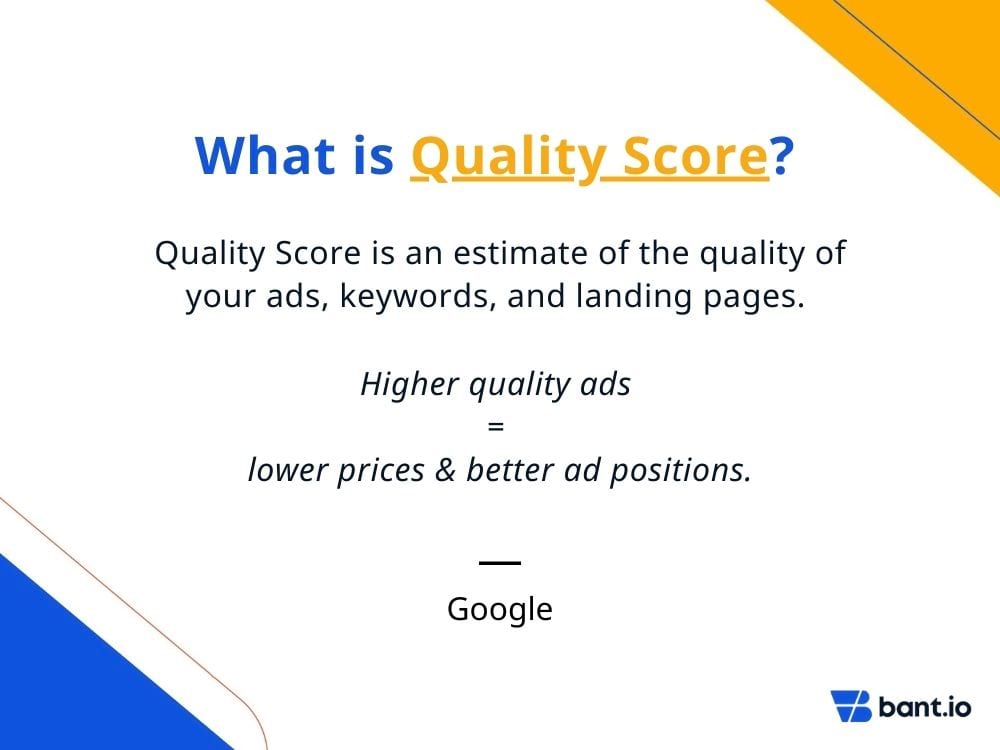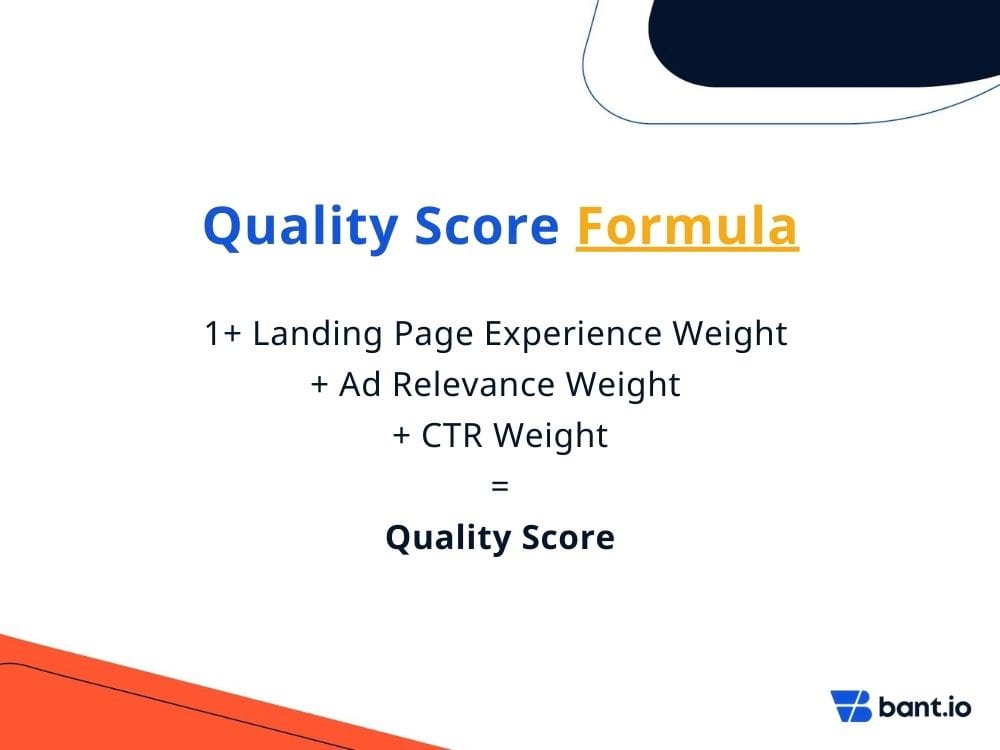You’ve selected your keywords, included the negative keywords, made sure your ad text is compelling and linked it to an awesome landing page. It’s ready to go; you press the button then check your Google Ads Quality Score only to find that it’s not what you expected; it’s way too low.
You’ve done everything correctly so why is it so low? A below-average Quality Score will lead to your ads being displayed with less frequency, a wasted budget and a poorly-performing campaign. The higher your Quality Score, the better your ad rank and click-through rate, and the lower your cost-per-click.
The aim of most PPC ad campaigns is to generate leads for your sales team to build their prospect list. If your online campaigns are delivering a below-average Quality Score, leads are going to be few and far between.
But it’s not all doom and gloom. There are a number of ways to improve your Google Ads Quality Score. But before you start to make any changes, it’s better to understand exactly what Google means by Quality Score, or QS, and how they calculate it.
What Is Quality Score?
With 33% of people clicking on a paid search ad because it directly answers their search term, the better your QS, the more likely your ad will appear in front of a user.
Let’s start with a definition from Google:
“Quality Score is an estimate of the quality of your ads, keywords and landing pages. Higher quality ads can lead to lower prices and better ad positions.”

Essentially, the better your landing page experience is to the user and the more relevant your ad is, the higher your QS will be according to the overall performance of your Google Ads campaign. Each keyword will have a QS which can be viewed in the Quality Score column of your Google Ads report. To the left of this column are other relevant columns to QS, such as landing page experience and ad relevance.
These status columns will display the real-time QS factors that influence the performance of your ad. You can set the display as current column values or historical column values.
So, why is your QS important to your Google Ads performance? Well, the higher the QS, the better the quality of your ad, according to Google, and the more likely your ad will be shown in search queries. Google determines the relevance of your ad and landing page experience through your Quality Score. The more likely your ad will exactly match the user context in a search term on a search engine, the higher the position your ad will be in online searches.
Improving your QS has a number of benefits:
- If your PPC campaign has QS or 8 or above, Google rates your ads as high quality. This leads to a better ad performance in ad auctions and therefore, top rankings in search advertising.
- Improving your QS is likely to promote your ad to a better ad placement and higher ranking.
- A lower CPC equates with higher ad quality. This is because higher quality ads on Google have a lower ad rank threshold and therefore, reduced CPCs.
- A lower cost per conversion because your ad is more relevant to the user and the more likely people will click through to your landing page.
How is Quality Score Calculated?
Your search advertising is given a score by Google between 1 and 10, with 1 being the lowest score and 10 being the highest. The QS is made using three factors – CTR, ad relevance and landing page experience. Each of these is given a rating of above average, average and below average. The QS formula is:
1+ Landing Page Experience Weight + Ad Relevance Weight + CTR Weight

Google measures landing page experience in terms of “how relevant and useful your landing page will be to people who click your ad.” Google expects your landing page to be “clear and useful” and “related to your keyword and what your customers are searching for.”
By clear they mean your landing page design should have a conversion ratio of 1:1, i.e. only one link or call-to-action button. It should be readable, informative and engaging.
The content should be useful, easy to read and include all the details about your offer to help the user make a decision. It’s a good idea to use images, videos or infographics on your landing page.
With landing page relevance, it should only contain information about the topic you are advertising, i.e. the offer. The more personalized it is, the better. Ensure your relevant keywords are in the headline and throughout the landing page content.
The second factor is ad relevance. This is related to your single keyword or keywords. When looking at keyword relevance, ensure they aren’t broad match keywords but more specific to a search term. The more relevant your ad is to the keyword groups, the higher the ad relevance and QS score.
Lastly is click-through rate, or CTR. Again, related to your keywords, the expected CTR measures whether a user will click on your ad when associated with a user’s search intent. The ad position or any ad extensions are not taken into account, however previous keyword reports based on former ad positions are considered.
QS is often confused with ad rank but they are different. Whilst Google uses both to evaluate your ad campaign, QS is a tool that helps advertisers to adjust and improve their ad campaigns. However, ad rank determines where your ad will appear on search engine results pages (SERPs).
How to Increase Your Google Ads Quality Score?
There are three ways to increase ad quality and QS. One is to increase the ad relevance; secondly, improve your expected CTR and thirdly, the landing page experience. Ensuring the keyword match type is relevant to your ad and user search queries will have an impact on your QS.
Firstly, let’s look at ad relevance to improve your keyword quality score. With most Google Adwords ads, there will be more than a single keyword. Splitting your campaign into keywords that are performing well and keywords that have a below-average rating helps to reduce the size of your ad groups.
For each campaign, ensure your ad content is specific and answers a user’s search term. Adjust the headline, the call-to-action and value proposition. Add negative keywords to make sure that your ad does not appear in irrelevant searches.
Google weights your expected CTR based on a predicted percentage of your click-through rate together with previous performance of search keywords. To improve your CTR, ensure negative keywords are included.
It’s a good exercise to compare your actual CTR with Google’s predicted CTR. If the expected CTR is above average, focus on the other two elements. Utilizing Bant.io’s PPC ads tracking and measurement platform is a great way to constantly monitor the performance of your PPC ad campaigns. Their online dashboard is a proven PPC lead generation tool that leverages Google Ads’ campaign data, enabling you to adjust and adapt your online ads where necessary.
Lastly, it’s optimizing the landing page experience for users. This element is the most comprehensive and is the only one that doesn’t rely on keywords. Ask five questions:
- Does your landing page answer the user’s search intent?
- Is your landing page content original?
- Is the content clear and reflects the offer?
- Is the landing page design easy to navigate?
- Is the call-to-action button easy to find and relevant?
Landing page load time is crucial, particularly when users are browsing on mobile devices. Only 50% of landing pages are currently optimized. If your landing page doesn’t load quickly you’ve lost a potential customer. B2B sales lead generation is important to any business; without a driven, hardworking sales team, you are not going to benefit from online advertising.
The first rule of landing pages is to make sure it includes just one offer per page. According to Marketing Experiments, landing pages that have more than one offer could potentially reduce conversions by 266%
Embedding a video or quality image can increase conversions by 85%, according to Eyeview, but only if they are relevant. Hubspot’s research found that businesses that have 10 to 15 landing pages can increase their leads by 55%.
Personalize your content to reach your target audience and meet their needs. Match your ad’s headline with your landing page design.
Ultimately, your Quality Score has to reflect an above-average rating for your expected CTR, landing page experience and ad relevance. The better the QS, the higher the conversion rate which leads to increased lead generation and sales conversion.
Your Quality Score and CTR are more closely related than you think. Not sure what exactly CTR is? We got it all covered in our guide: Click Rate VS Open Rate.
FAQs
What is the Quality Score based on?
Google measures your Quality Score based on ad relevance, landing page experience and expected click-through rate of your online ads.
Does CTR help improve the Quality Score?
By improving a below-average expected CTR, it can have a significant impact on increasing your Quality Score. Google will rate expected CTR, which can be compared to the actual CTR to evaluate if the CTR needs improving.
How do you optimize the Quality Score?
To increase the Quality Score:
- Optimize your landing page to ensure the content is relevant to a user’s search intent, details the benefits to the visitor, includes relevant keywords, is clear and contains just one call-to-action button.
- Keep your ad groups small with relevant exact match keywords, and include negative keywords.
- Ensure your ad content contains the relevant keywords and matches your landing page content.
- Improve a below-average expected CTR.
What is Quality Score and how does it affect Google Ads?
Quality Score is a Google Ads measurement that helps advertisers to understand the performance of their online ads. The lower Google has rated the Quality Score, the less likely your ad will appear in the top search network ads and the higher your cost-per-click will be.

